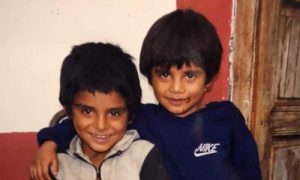Around midnight the violin struck up a lively jig accompanied by the beat set by an eight-stringed guitarra and a jarana, which looks like a mini-guitar. Could it be …? Yes! “El Corre Caballo!”

I made a brief video of the song’s start, then leapt to the dance floor. From across the room two young men in jeans, colorful western-style shirts, cowboy boots and white cowboy hats jumped up to meet me there. Shortly after we were flatfooting across the floor, we were joined by a woman in an evening gown holding the hand of her toddler son, and we made our way as part of a larger crowd.
“Corre caballo, salta la orilla / brinca las trancas de Panco Villa,” the singer sang in falsetto. “Mi caballito muy obediente es el que monta mi president.” Run horse – jump the edge. Jump the fence of Panco Villa. My very obedient horse is the one my president rides.
The young man in the darker shirt did fancy footwork and held my hand and laughed, smiles lighting his face, and my heart filled with joy.
Almost 30 years ago, we did the same dance. I had by then traveled a few times to his remote Mexican village, where the lifestyle enchanted me, and children were always with me, running along mountain paths with me, showing me everything.

That back then, though, was new for me: It was this village’s festival week, a week in fall which honors Saint Rafael, the namesake of the village. When I arrived for the festivities that week everyone was asking: Will the guera (light-skinned woman) dance the huapango?
Yes, I assured them, I would! I had been told that it was the traditional dance of the Huasteca Indians, whose blood was mixed for generations with that of Spaniards and Frenchmen from centuries back.
Of course, when they said traditional dance of the Indians, back then the only reference I had was what the images children of the 1970’s like me had, of Indians stomping around a campfire, and I was prepared to do that.
Imagine my surprise when the huapango music sounded a whole lot like bluegrass. The first song I heard at the community dance was “El Corre Caballo,” and a dozen children pulled me up and led me to the center of the town square, between the church and the jailhouse. Along with all the others we flatfooted around and around the pavement, joyously laughing.
I had the feeling then that this was one of those magical moments I’d remember for the rest of my life, and I was right.
One of those youngsters was Mauricio, a shy but smiley toddler who would spend a lot of time with me when I visited. Over the years I saw him grow up to become a cheerful, enthusiastic teenager.
Eventually I stopped traveling, and we lost touch. There wasn’t any way to keep in touch, as there wasn’t much phone service back then, and the mail didn’t make it.
Once Mauricio grew up, though, he found his “Mama Holly” on Facebook. Those little children I loved so much back then had grown into adults who had to emigrate to big cities to make a living. Mauricio and several of his cousins are now in North Carolina and invite me to family functions. The rest of the kids honor me by calling me “tia” – aunt – though Mauricio, his sister and a cousin call me Mama.
The adventures I had ages ago with those kids enriched my life beyond measure, and I thought I’d never know such magic again. Yet thanks to the wonders of coincidence, which has brought some of them within driving distance, and music, which brings joy on so many levels, the adventures continue.
But is that coincidence, or a blessing from above?
Saturday night Mauricio asked me if I remembered dancing to “El Corre Caballo” with him and the other children all those years ago back in his village.
“Claro que si!” – Of course!
As the song ended, we hugged, then went back to our tables.
I pulled out my phone and sent the brief video I had made of the start of the song to Mauricio’s sister, Estela, and their cousin, Sofia, who now live in Monterrey, Nuevo Leon, Mexico.
Both of them responded with heart emojis and exclamations of our dancing that one together so long ago.
How life comes back to itself, and what a treasure it is to learn that one’s own precious memories are also just as important to the others who helped make them.





